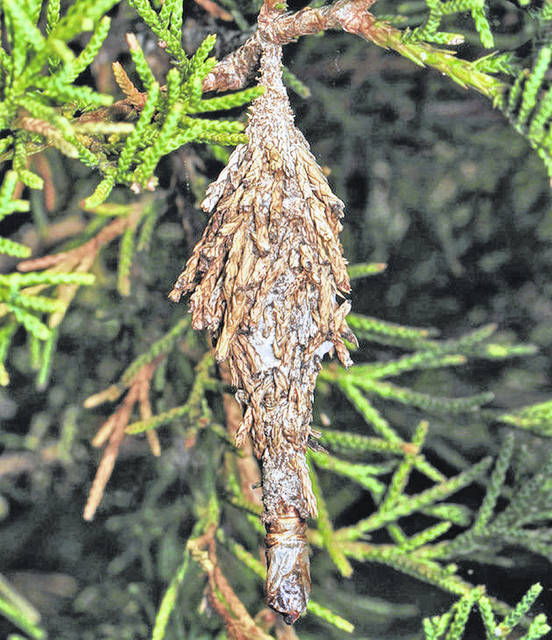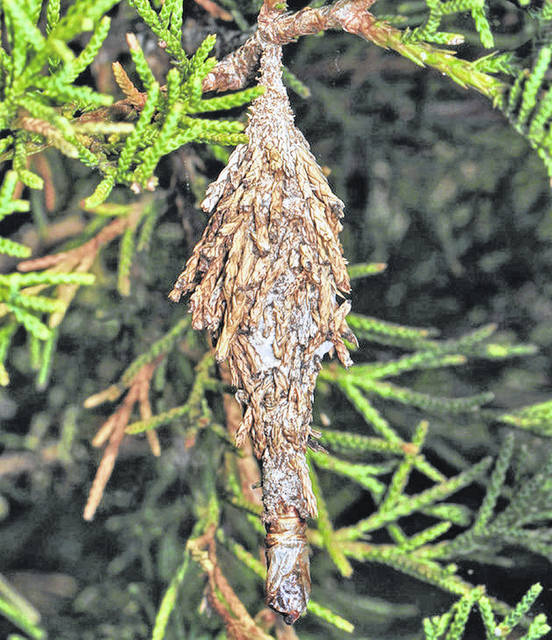



Have you ever been surprised by large bare patches of dead foliage on your evergreens?
If you look closely you might see cone-shaped pendants of dead foliage hanging from the dead twigs: BAGWORMS!
Late April and early May are critical to controlling bagworms, so if you have any pines, spruce, or arborvitae in your landscape you should check for bagworm damage from last year and take action right away if you see any signs of bagworms.
Bagworms are best known for attacking evergreens, but they also eat barberry, blackberry, box elder, cherry, clematis, cotoneaster, elm, locust, maple, oak, peach, poplar, pyracantha, rose, sumac, sycamore and willow.
People often confuse tent caterpillars and bagworms, so let’s make sure we’re talking about the right one. Bagworms create camouflaged homes for themselves out of leaves and evergreen needles, which they carry around on their backs.
These shelters get larger and larger as the worms grow, and they protect the worms from sprays and predators. Bagworms are tiny at first, and by the time you can see them they will be very hard to control.
Baby bagworms are about the size of the point on a sharpened pencil lead. They start feeding as soon as they hatch, and they quickly start growing and spinning silken bags studded with bits of dead foliage around their bodies for protection.
Spraying is most effective in early spring when they’re too small to see with the naked eye. The longer you wait after that, the bigger the bagworms and their damage will be, and, the more protection their bag will provide.
By late summer, a mature bag actually repels pesticide sprays, and the worms are too big for most insecticides to kill. This is why you need to act now.
There are many sprays and chemicals to control bagworms, if your timing is right. Chemical controls include acephate (Orthene from Ortho), bifenthrin, carbaryl (Sevin and Eight), cyfluthrin (Bayer Lawn & Garden Insecticide), cyhalothrin, malathion, or permethrin.
“Eight” from Bonide has both carbaryl and permethrin, so that’s the one we like best. All of these controls work by poisoning the plant leaves, so that bagworms are poisoned when they eat your plants.
Organic sprays work by ruining the bagworm’s appetite, causing them to starve. Using organics will not harm beneficial insects. Organic options include Bacillus thuringiensis (also called BT) and spinosad.
Our favorite organic control for bagworms, “Captain Jack’s Deadbug Brew” from Bonide, has both. This is a good all-purpose insecticide that works on many other garden pests, and it is an OMRI-approved organic remedy.
Simply spray the entire plant thoroughly, wetting all the leaves, in early spring, and again when the leaves are fully open.
Left untreated, bagworms will strip the needles or leaves from ever-larger patches of your trees and shrubs, working their way from bottom to top, and spreading to nearby plants.
They’ll even attach themselves to your siding or crawl up your vehicles. Take a few minutes to walk around your yard and inspect your plants. If you see even one bagworm dangling there, you can expect more.
Take action now, while you can still prevent further damage.
Steve Boehme is a landscape designer/installer specializing in landscape “makeovers”. “Let’s Grow” is published weekly; column archives are on the “Garden Advice” page at www.goodseedfarm.com. For more information is available at www.goodseedfarm.com or call GoodSeed Farm Landscapes at (937) 587-7021.



